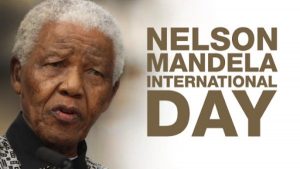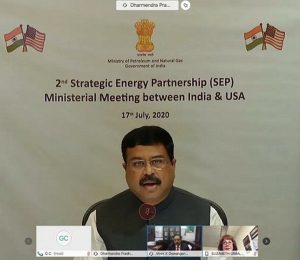Daily Current Affairs for Government Exams:
Today Current Affairs: 18th July 2020 for UPSC IAS exams, State PSC exams, SSC CGL, State SSC, RRB, Railways, Banking Exam & IBPS, etc
Table of Contents
Contents:
- Nelson Mandela International Day :
- US-India Strategic Energy Partnership:
- ‘Trinity Test’.:
- Kerala Animals and Birds Sacrifices Prohibition Act:
- The challenge to Anti Defection Law:
- Global Multidimensional Poverty Index 2020:
- .Maternal mortality ratio:
- State of Food Security and Nutrition in the World (SOFI) 2020 report:
- Other important current affairs
1.Nelson Mandela International Day :

Nelson Mandela International Day is an annual international day in honor of Nelson Mandela, celebrated each year on 18 July, Mandela’s birthday
- The day was officially declared by the United Nations in November 2009, with the first UN Mandela Day held on 18 July 2010.
- The Day is a global call to action that celebrates the idea that each individual has the power to transform the world, the ability to make an impact.
Nelson Mandela:
- Nelson Mandela (1918 – 2013) was a South African anti-apartheid revolutionary who served as President of South Africa from 1994 to 1999. He was the country’s first black head of state and the first elected in a fully representative democratic election.
- He also served as Secretary-General of the Non-Aligned Movement from 1998 to 1999.
- He was awarded Bharat Ratna (in 1990) and Nobel Peace Prize (in 1993).
- United Nations has recognized the period from 2019 to 2028 as the Nelson Mandela Decade of Peace.
- The United Nations Nelson Rolihlahla Mandela Prize aims to recognize the achievements of those who dedicated their lives to the service of humanity as guided by the UN principles while honouring Mandela’s legacy of reconciliation, political transition, and social transformation.
- It is awarded every five years and was first awarded in 2015.
2.US-India Strategic Energy Partnership:

Recently, India and the USA have participated in a virtual ministerial meeting of the U.S.-India Strategic Energy Partnership (SEP) to review progress, highlight major accomplishments, and prioritize new areas for cooperation.
- The SEP was established in April 2018 whose objective is to encourage meaningful engagements through robust government-to-government cooperation and industry engagement.
- The next Ministerial meeting will be held in 2021.
Key Points
- The SEP organizes inter-agency engagement on both sides across four primary pillars of cooperation:
Power and Energy Efficiency, Oil and Gas, Renewable Energy, Sustainable Growth. - The SEP also supports USA efforts under the AsiaEDGE initiative, which establishes India as a strong energy partner in the Indo-Pacific region.
Major Outcomes: Number of achievements and priorities for new work under the SEP were announced by both sides. These can be broadly segregated under the four primary pillars of cooperation, as given below:
1. Power and Energy Efficiency:
- Modernizing the Power System: Both countries have been collaborating on the integration of new technologies into the smart grid; modernizing the power distribution sector i.e. rooftop solar, deployment of Smart Meters etc.
- The two countries are leading joint research and development (R&D) through Advance Clean Energy-Research (PACE-R) on smart grids and energy storage to increase resilience and reliability of the electric grid.
2. Oil and Gas:
- A Memorandum of Understanding (MoU) was signed to begin cooperation on Strategic Petroleum Reserves operation.
- The possibility of India storing oil in the U.S. Strategic Petroleum Reserve was also discussed.
- Both sides have noted the significant increase in the bilateral hydrocarbon trade through SEP touching 9.2 billion USD during 2019-20 and marking a 93% increase since 2017-18,
- Through the U.S.-India Natural Gas Task Force, it affirmed to promote greater hydrocarbon trade between the two countries.
3. Renewable Energy:
- Both sides launched a public-private Hydrogen Task Force to help scale up technologies to produce hydrogen from renewable energy and fossil fuel sources and to bring down the cost of deployment for enhanced energy security and resiliency.
4. Sustainable Growth:
- The best practices are being adopted through methodologies in energy data management and capacity building in energy modeling.
- USAID and NITI Aayog jointly launched the India Energy Modeling Forum to build a network of modeling communities and its linkage with Government for analytical work and policy-making exercise.
- Empowering Women in the Energy Sector: USAID launched the South Asia Women in Energy (SAWIE) platform focused on the power sector and both the countries have been working to incorporate gender-focused activities across the technical pillars.
3.‘Trinity Test’.:

On July 16, 1945, exactly 75 years ago, scientists tested Gadget — the world’s first atomic bomb — in what was dubbed as the ‘Trinity Test’.
- Trinity was the code name of the first detonation of a nuclear device.
- It was conducted by the United States Army on July 16, 1945, as part of the Manhattan Project.
- The test was conducted in the Jornada del Muerto desert about 56 km southeast of Socorro, New Mexico. The test was planned and directed by Kenneth Bainbridge.
- The test was of an implosion-design plutonium device, informally nicknamed “The Gadget”, of the same design as the Fat Man bomb later detonated over Nagasaki, Japan, on August 9, 1945.
Manhattan Project:
- The Manhattan Project was a research and development undertaking during World War II that produced the first nuclear weapons.
- It was led by the United States with the support of the United Kingdom and Canada.
4.Kerala Animals and Birds Sacrifices Prohibition Act:

The Supreme Court has agreed to examine the constitutional validity of the Kerala Animals and Bird Sacrifices Prohibition Act of 1968.
- An appeal is filed in the Supreme Court by people who are Shakthi worshippers, and for whom, animal sacrifice is an integral part of the worship.
- In their appeal, they said the animal sacrifice was an “essential religious practice”.
- But, the 1968 State law bans the killing of animals and birds for religious sacrifices. However, the act does not ban killing for personal consumption.
- This amounted to arbitrary classification and is violative of Article 14 of the Constitution.
- It also violates the right to practice religion and manage religious affairs under articles 25 and 26 of the Constitution.
- The appellants said if the killing of animals and birds was to be prohibited, let it be so for all purposes – religious or otherwise.
- Besides, Section 28 of the Prevention of Cruelty to Animals, 1960 does not make the killing of animals for religious purposes an offense.
- Recently, the Kerala High Court had dismissed the PIL on the ground that no material was brought on record to establish that the practice was essential to the religion.
- The High Court had observed that the Prevention of Cruelty Act does not have the word “sacrifice” for the purpose of religion.
5.The challenge to Anti Defection Law:

Recently, the 19 rebel MLAs of Rajasthan’s ruling party (Congress) have filed a petition before the High Court challenging the disqualification notices issued to them by the Assembly Speaker under Anti Defection Law.
- The disqualification notice was issued on MLAs’ absence from successive Congress Legislature Party (CLP) meetings and a “conspiracy to bring down the government”.
Rebel MLAs Arguments:
- In their writ petition, citing violation of their freedom of speech and expression the legislators argued that they had neither given up their membership of the House nor did their failure to attend the two CLP meetings render them liable for disqualification on the ground of defection.
- Therefore they challenged Clause 2(1)(a) of the Tenth Schedule of the Constitution, and the validity of the Rajasthan Assembly Members (Disqualification on the Grounds of Changing Party) Rules, 1989.
- Clause 2(1)(a) of the Tenth Schedule states that a member may be disqualified “if he has voluntarily given up his membership” of a political party.
- They also contended that they could not be disqualified merely for disagreeing with the decisions and policies of some leaders outside the Assembly.
- Supreme Court’s Ruling: The Supreme Court in the Kihoto Hollohan versus Zachillu and Others, 1992 has said that judicial review cannot be available at a stage prior to the making of a decision by the Speaker/Chairman.
- Nor would interference be permissible at an interlocutory stage of the proceedings.
- The only exception for any interlocutory interference (decree or judgment) being cases of interlocutory disqualifications or suspensions which may have grave, immediate and irreversible repercussions and consequences.
- Therefore, Constitutional courts cannot judicially review disqualification proceedings under the Tenth Schedule (anti-defection law) of the Constitution until the Speaker or Chairman makes a final decision on merits.
- The Bench explained that the reason for limiting the role of courts in ongoing defection proceedings is that the office of the Speaker is held in the highest respect and esteem in parliamentary traditions.
- Judicial Review: It had said that even the scope of judicial review against an order of a Speaker or Chairman in anti-defection proceedings would be confined to jurisdictional errors, that is infirmities based on a violation of constitutional mandate, mala fide actions, and non-compliance with rules of natural justice.
6.Global Multidimensional Poverty Index 2020:

Recently, the Global Multidimensional Poverty Index 2020 was released by the United Nations Development Programme (UNDP) and the Oxford Poverty & Human Development Initiative (OPHI).
- The data of the index is based on the study of poverty trends in 75 countries.
Global Scenario:
- 1.3 billion people are still living in multidimensional poverty. More than 80% are deprived in at least five of the ten indicators used to measure health, education and living standards in the global MPI.
- The burden of multidimensional poverty disproportionately falls on children – half of multidimensionally poor people are children under age 18.
- 65 out of 75 countries studied significantly reduced their multidimensional poverty levels between 2000 and 2019.
- About 84.3% of multidimensionally poor people live in Sub-Saharan Africa and South Asia.
67% of multidimensionally poor people are in middle-income countries.
Indian Scenario:
- India lifted as many as 270 million people out of multidimensional poverty between 2005-06 and 2015-16.
- Neighbourhood Scenario: In China, 70 million people left multidimensional poverty between 2010 and 2014, while in Bangladesh, the numbers declined by 19 million between 2014 and 2019.
- Impact of Covid-19: Covid-19 is having a profound impact on the development landscape.
- The study finds that on average, poverty levels will be set back 3 to 10 years due to Covid-19.
- Sustainable Development Goals: The index emphasizes on measuring and monitoring progress under the goals to reach ‘zero poverty by 2030-Goal 1 of the SDGs’.
Multidimensional Poverty Index
- The Multidimensional Poverty Index was launched by the UNDP and the OPHI in 2010.
- MPI is based on the idea that poverty is not unidimensional (not just depends on income and one individual may lack several basic needs like education, health etc.), rather it is multidimensional.
- The index shows the proportion of poor people and the average number of deprivations each poor person experiences at the same time.
- MPI uses three dimensions and ten indicators which are:
- Education: Years of schooling and child enrollment (1/6 weightage each, total 2/6);
- Health: Child mortality and nutrition (1/6 weightage each, total 2/6);
- Standard of living: Electricity, flooring, drinking water, sanitation, cooking fuel and assets (1/18 weightage each, total 2/6)
7.Maternal mortality ratio:

The Office of the Registrar General’s Sample Registration System (SRS) released the special bulletin on Maternal Mortality in India 2016-18.
- The Maternal Mortality Ratio (MMR) in India has declined to 113 in 2016-18 from 122 in 2015-17 and 130 in 2014-2016.
- The MMR of various States according to the bulletin includes Assam (215), Bihar (149), Madhya Pradesh (173), Chhattisgarh (159), Odisha (150), Rajasthan (164), Uttar Pradesh (197) and Uttarakhand (99).
- The southern States registered a lower MMR — Andhra Pradesh (65), Telangana (63), Karnataka (92), Kerala (43), and Tamil Nadu (60).
- MMR is defined as the number of maternal deaths per 1,00,000 live births.
- The target 3.1 of Sustainable Development Goals (SDG) set by the United Nations aims to reduce the global maternal mortality ratio to less than 70 per 1,00,000 live births.
- As per the World Health Organization, maternal death is the death of a woman while pregnant or within 42 days of termination of pregnancy, from any cause related to or aggravated by the pregnancy or its management.
8. State of Food Security and Nutrition in the World (SOFI) 2020 report:

The State of Food Security and Nutrition in the World (SOFI) 2020 report was released on the sidelines of the High-Level Political Forum (HLPF) on Sustainable Development which tracks the progress of nations towards achieving Sustainable Development Goals 2030.
- It is produced jointly by the Food and Agriculture Organisation of the United Nations (FAO), the International Fund for Agricultural Development (IFAD), the United Nations Children’s Fund (UNICEF), the UN World Food Programme (WFP) and the World Health Organisation (WHO).
- Its first edition was brought out in 2017.
Key highlights of the report:
- The world is not on track to meet the goal of zero hunger by 2030 i.e. SDG2.
- Between 8.3 crore and 13 crore, people globally are likely to go hungry this year due to the economic recession triggered by COVID-19.
- Hunger continues to be on the rise since 2014 and the global prevalence of undernourishment, or the overall percentage of hungry people, is 8.9%. Almost 69 crore people went hungry in 2019 — up by 1 crore in 2018
- Asia remains home to the greatest number of undernourished (38 crores). Africa is second (25 crores), followed by Latin America and the Caribbean (4.8 crores).
- In 2019, 21.3% (14.4.crore) of children under 5 years were stunted, 6.9% (4.7 crore) wasted and 5.6% (3.8 million) overweight.
- A healthy diet costs more than ₹143 (or $1.90/ day), which is the international poverty threshold. The number of people globally who can’t afford a healthy diet is at 300 crore people or more than the combined population of China and India.
Other important current affairs:
1. A start-up incubated in the Indian Institute of Technology (IIT), Madras, has developed a portable hospital.
- Called ‘MediCAB,’ the portable structures can be used to screen, isolate, and treat COVID-19 patients even in remote locations.
- The students involved in the project say the modular structure can be installed anywhere within two hours by just four people.
2. Revamped PM’s Awards for Excellence in Public Administration has been launched.
- The Scheme has been revamped to recognize the performance of the District Collectors towards outcome indicators, economic development, peoples’ participation, and redressal of public grievances.
- Nominations have been called in four major categories – District Performance Indicators Programme, Innovation General Category, Aspirational Districts Program, and Namami Gange Program.
- The scheme for the very first time seeks to recognize the efforts of District level officials in the Namami Gange Programme.
- Under this award category, one award shall be given to a district out of the 57 notified District Ganga Committees under the Namami Gange Programme.
Background:
- The Government of India instituted “The Prime Minister’s Awards for Excellence in Public Administration” in the year 2006 to acknowledge, recognize and reward the extraordinary and innovative work done by Districts/ Organizations of the Central and State Governments.
- The Scheme was restructured in 2014 for recognizing the performance of District Collectors in Priority Programmes, Innovations, and Aspirational Districts and was further restructured in 2020 to recognize the performance of District Collectors towards economic development of the District.
- Now, For the year 2020, the scope of the awards has been expanded to identify areas of overall outcome-oriented performance in the districts across sectors.
3. The Ministry of Environment, Forest and Climate Change (MoEF&CC) has approved the Zonal Master Plan for the Bhagirathi Eco-Sensitive Zone to pave the way for faster execution of Char Dham Road Project.
- In 2012, the MoEF&CC issued a gazette notification declaring the watershed area along the stretch of river Bhagirathi, covering 4,179.59 sq km from Gaumukh to Uttarkashi, an Eco-Sensitive Zone (ESZ).
- ESZs are the ecologically important areas designated to be protected from industrial pollution and unregulated development under the Environment Protection Act of 1986.
- The 2012 notification was issued keeping in view the requirements of the local people without affecting their rights and privileges and also ensuring eco-friendly development for their livelihood security.
- It sought to protect the entire fragile Himalayan region by restricting hydropower projects of over 2 MW, riverbed mining, and change of land use.
- However, it was amended in 2018 following the Uttarakhand government’s objection that the notification was ‘anti-development.’
- The 2018 amendment approved a land-use change to meet the local needs including civic amenities and other infrastructure development in the larger public interest and national security with the prior approval of State
- Zonal Master Plan (ZMP):
- The Bhagirathi Eco-Sensitive Zone notification mandates the State Government of Uttarakhand to prepare ZMP to be implemented under the supervision of the Monitoring Committee.
- The ZMP is based on the watershed approach and includes governance in the area of forest and wildlife, watershed management, irrigation, energy, tourism, public health and sanitation, road infrastructure, etc.
5. The National Green Tribunal (NGT) has issued an order pertaining to the case of legacy waste (old municipal solid waste) piling up at the Kochi Corporation’s Brahmapuram dumpsite.
- The NGT Judgement:
- The Chairman and Member Secretary of the Kerala State Pollution Control Board (KSPCB) will be held liable if they fail to initiate prosecution and recover compensation from those responsible for the unscientific handling of waste at the Brahmaputra.
- The progress (remediation of waste) appears to be very slow and is disregardful of the statutory and constitutional obligation of providing a clean environment.
- Further, the tribunal asked why there should be a bar on a single tender considering the critical situation.
- The government decided to float fresh tenders as only one agency had met the minimum eligibility criteria when an e-tender for biomining of legacy waste at Brahmapuram was floated on 20th March, 2020.
- The Bench suggested that other available options (besides biomining) be considered for compliance with Solid Waste Management Rules, 2016.
- The tribunal expressed doubts on whether the leachate (the dark liquid that gets generated within the solid waste) generated at the dumping yard could be treated in an ordinary septage treatment plant as it contained heavy metals.
6. The All India Rice Exporters’ Association (AIREA) has appealed to the government to preserve and protect the integrity of Basmati rice, following Madhya Pradesh (MP) government’s pressure on the central government for seeking Geographical Indication (GI) tag for Basmati produced in 13 districts of MP.
- AIREA argues that if MP is included in the GI list of Basmati crop then it will harm the reputation of Indian Basmati as well as the national interest.
- Geographical Indication Tag:
- According to the Agricultural and Processed Food Products Export Development Authority (APEDA), it is given to an agricultural, natural, or manufactured product, originating from a specific geographical area due to which it possesses unique characteristics and qualities.
- GI tag is kind of a trademark in the international market and an assurance that the product is coming from that specific area.
- Basmati and GI tag:
- India is the only producer of premium Basmati and it has been grown from time immemorial in the Indo-Gangetic Plains (IGP) area of India and 18 districts of Pakistan’s Punjab.
8. The International Centre of Automotive Technology (ICAT) is developing a technology platform for the automotive industry called ASPIRE – Automotive Solutions Portal for Industry, Research, and Education.
- The Portal is expected to help in developing a strong and self-reliant automotive industry in India which is in tune with the vision of Make in India and Atmanirbhar vision of the Government of India.
- The Portal is being developed in line with the initiative by the Department of Heavy Industry (DHI) under the Ministry of Heavy Industries & Public Enterprises.
- DHI has taken an initiative to promote innovation and to develop the related ecosystem.
- Objective: To enhance the technological capability of the Indian automotive sector through exchange of knowledge & expertise, in order to make them self reliant and to facilitate the growth of the automobile sector and overall socio-economic progress of the country.




